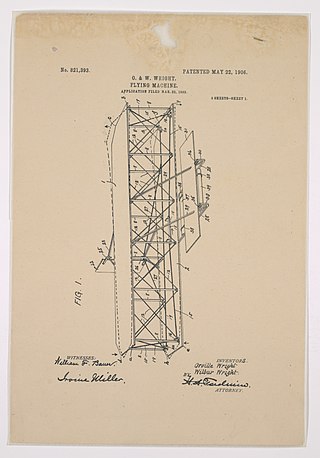Related Research Articles

A fixed-wing aircraft is a heavier-than-air flying machine, such as an airplane, which is capable of flight using wings that generate lift caused by the aircraft's forward airspeed and the shape of the wings. Fixed-wing aircraft are distinct from rotary-wing aircraft, and ornithopters. The wings of a fixed-wing aircraft are not necessarily rigid; kites, hang gliders, variable-sweep wing aircraft and airplanes that use wing morphing are all examples of fixed-wing aircraft.

The Wright brothers, Orville Wright and Wilbur Wright, were American aviation pioneers generally credited with inventing, building, and flying the world's first successful motor-operated airplane. They made the first controlled, sustained flight of a powered, heavier-than-air aircraft with the Wright Flyer on December 17, 1903, four miles south of Kitty Hawk, North Carolina, at what is now known as Kill Devil Hills. The brothers were also the first to invent aircraft controls that made fixed-wing powered flight possible.

An aileron is a hinged flight control surface usually forming part of the trailing edge of each wing of a fixed-wing aircraft. Ailerons are used in pairs to control the aircraft in roll, which normally results in a change in flight path due to the tilting of the lift vector. Movement around this axis is called 'rolling' or 'banking'.

The history of aviation extends for more than two thousand years, from the earliest forms of aviation such as kites and attempts at tower jumping to supersonic and hypersonic flight by powered, heavier-than-air jets.

Aircraft flight control surfaces are aerodynamic devices allowing a pilot to adjust and control the aircraft's flight attitude.
This is a list of aviation-related events from 1905:
This is a list of aviation-related events from 1904:
This is a list of aviation-related events during the 19th century :

The Wright Flyer made the first sustained flight by a manned heavier-than-air powered and controlled aircraft—an airplane—on December 17, 1903. Invented and flown by brothers Orville and Wilbur Wright, it marked the beginning of the pioneer era of aviation.

An airplane, or aeroplane, informally plane, is a fixed-wing aircraft that is propelled forward by thrust from a jet engine, propeller, or rocket engine. Airplanes come in a variety of sizes, shapes, and wing configurations. The broad spectrum of uses for airplanes includes recreation, transportation of goods and people, military, and research. Worldwide, commercial aviation transports more than four billion passengers annually on airliners and transports more than 200 billion tonne-kilometers of cargo annually, which is less than 1% of the world's cargo movement. Most airplanes are flown by a pilot on board the aircraft, but some are designed to be remotely or computer-controlled such as drones.

Early flying machines include all forms of aircraft studied or constructed before the development of the modern aeroplane by 1910. The story of modern flight begins more than a century before the first successful manned aeroplane, and the earliest aircraft thousands of years before.

The Curtiss Model N was a military trainer used primarily by the United States Navy during World War I.

A glider is a fixed-wing aircraft that is supported in flight by the dynamic reaction of the air against its lifting surfaces, and whose free flight does not depend on an engine. Most gliders do not have an engine, although motor-gliders have small engines for extending their flight when necessary by sustaining the altitude with some being powerful enough to take off by self-launch.

Edson Fessenden Gallaudet was a pioneer in the field of aviation. He was best known for his development of practical airfoils and aircraft propulsion systems for use in early seaplanes.

The Wright brothers patent war centers on the patent that the Wright brothers received for their method of airplane flight control. They were two Americans who are widely credited with inventing and building the world's first flyable airplane and making the first controlled, powered, and sustained heavier-than-air human flight on December 17, 1903.
The Handley Page Type A, sometimes called "Bluebird" and later designated HP.1, was the first powered aircraft designed and built by Frederick Handley Page.

The Hannover H.1 Vampyr was a German glider designed by Georg Madelung for the 1921 Rhön gliding competition, which was held at the Wasserkuppe from 8 August to 25 August 1921. The Vampyr is believed to be the first heavier than air aircraft to use stressed skin. Several historical societies have argued that the aircraft is the precursor of all modern sailplanes.

The pioneer era of aviation was the period of aviation history between the first successful powered flight, generally accepted to have been made by the Wright Brothers on 17 December 1903, and the outbreak of the First World War in August 1914.
The Siegel MS 1 was a very light, simple, foot-launched glider designed, financed, built and flown by a Polish schoolteacher in the 1923 summer holidays. It made some short hops but was easily damaged.
References
- ↑ Massachusetts Institute of Technology. Alumni Association. War Records Committee. Technology's war record: an interpretation of the contribution. p. 704.
- ↑ "Flying Machines" . Retrieved 28 December 2011.
- ↑ Tom Couch (September 2009). "Oldies and Oddities: Where Do Ailerons Come From?". Air & Space Magazine.
- ↑ Harwood, Craig S. and Fogel, Gary B. Quest for Flight: John J. Montgomery and the Dawn of Aviation in the West, University of Oklahoma Press 2012.
- 1 2 "Trying Out Norwich Built Hydroplane on the Thames". The News. 3 August 1916.
- ↑ "Galludet Glider" . Retrieved 28 December 2011.
- ↑ "Washington D.C. Gallaudet". Archived from the original on 26 April 2012. Retrieved 28 December 2011.
- ↑ United States. Patent Office (6 February 1917). Official gazette of the United States Patent Office, Volume 235. p. 20.
- ↑ "Gallaudet Hydroplane" . Retrieved 26 December 2011.